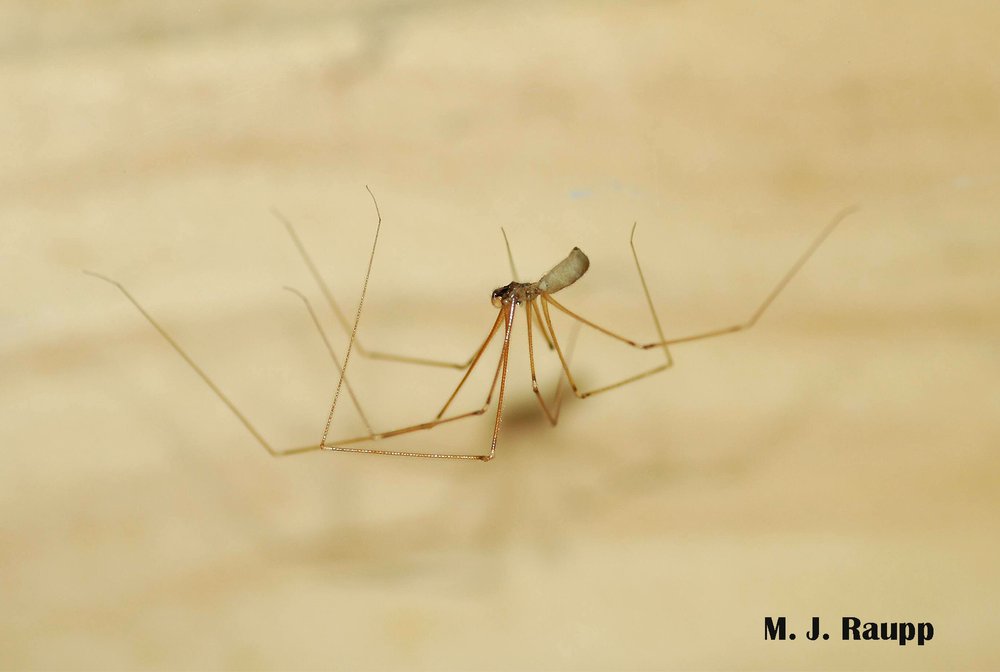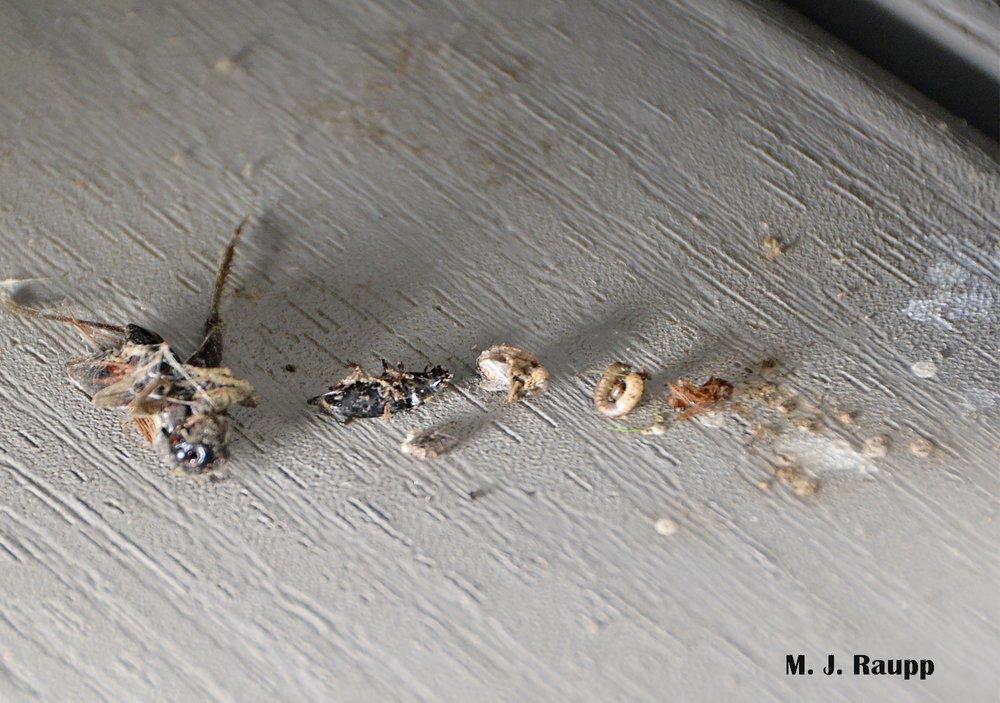Me and my shadow: Cellar spider, Pholcus phalangioides

It’s easy to see why cellar spiders are often called daddy-long-legs.

A pile of tiny insect carcasses and some white droplets of spider excrement mark the spot beneath a cellar spider’s lair.
On a warm early winter day, while tidying up a screened porch, I happened upon a lovely cellar spider taking a stroll with its shadow along piece of misplaced lumber. Somehow, that old classic by Al Jolson, Billy Rose, and Dave Dreyer got stuck in my mind and wound up in the title of this episode, but here’s the rest of the story. Just beneath a nearby workbench rested a motley collection of exsanguinated arthropods including a field cricket, ground beetle, weevil, small millipede, and tiny wasp tangled in silk. Telltale white droplets of excrement beneath a loose silken web marked this as the graveyard of victims of a cellar spider. A few years ago, in late autumn with the holiday season fast approaching and family and friends soon to visit, the Bug Guy received orders to prepare the spare bedroom in the basement for overnight guests. Part of the assignment was to inspect windows and remove any arthropods living or dead that might terrorize visitors who do not share affection for animals lacking fur and possessing more than four legs. Near the corner of one dimly lit window, I discovered a diverse collection of tiny insect carcasses and didn’t have to look far to see a gangly and beautiful cellar spider hiding in the upper corner of the window.
With the late autumn sunlight at just the right angle, a cellar spider takes a stroll with its shadow along a piece of lumber near my workbench. High on an interior wall with her egg case snugly tucked beneath her body, a mother cellar spider rests. While she spends most of her time building webs, catching prey, or just chilling out, watch what happens when she is disturbed by a bug geek. Rock on spider, rock on! Rocking the web is believed to be an anti-predator behavior in cellar spiders and many of their kin.
Cellar spiders are found throughout much of the world in temperate and tropical regions. Millions of years ago cellars were noticeably absent from the planet but caves and dank tree hollows were aplenty and cellar spiders found these habitats perfect for building their loose webs for snaring prey. In the Land Down Under and in some other parts of the world, cellar spiders go by the name of daddy-long-legs, a moniker associated with another arachnid, opilionids, which we met in a previous episode. I have handled cellar spiders and never been bitten and if this rare event did happen, the spider’s bite is reported to be harmless to humans. However, the cellar spider can bring down formidable spiders including Australian redbacks, kin to our black widow.
Mating is a curious affair in many spiders including Pholcus. Male cellar spiders deposit a droplet of sperm onto a small web, and then gather the droplet and store it in an appendage called the pedipalp. He then deposits the sperm into a cleft in the female’s abdomen where the sperm will be stored until the females uses the little wigglers to fertilize her eggs. Female cellar spiders are not necessarily “you and only you” kinds of gals and will often mate with more than one fella. In the spider mating game, it turns out that sperm from the last mating are the ones most likely to fertilize eggs. So, to ensure that he will be the proud father of spiderlings, the male removes sperm placed by his betrothed’s last suitor before he makes his deposit. What a guy. After all this drama, the female lays eggs and encases them in a thin cloak of silk. The egg bundle is toted about in their mother’s jaws to reduce the likelihood of being discovered and eaten by tiny predators. Like wolf spiders we met in a previous episode, tiny spiderlings also hitch a ride with mom for a short period of time after hatching. If some winter cleaning is on your to-do list, before you attack those corners in the basement with vacuum or duster, take a moment to observe and maybe even enjoy these helpful predators. Or not.
Acknowledgements
Bug of the Week thanks Dr. Jeffery Shultz for identifying the spider featured in this episode, Dr. Nancy Breisch, and the Bartley Raupp’s for providing inspiration and guidance for spider stories. Great references used to prepare this episode include “Daddy-long-legs Spider” by Dr. Mike Gray, and “Pholcus phalangioides” by Anna Ferrick.
This post appeared first on Bug of the Week